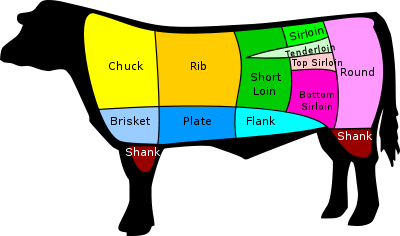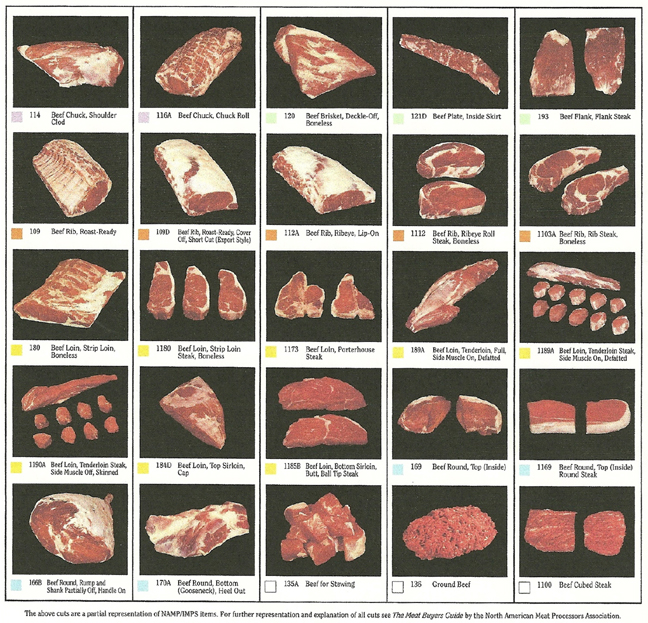LEARN ABOUT CUTS OF BEEF
Beef is first divided into primal cuts. These are basic sections from which steaks and other subdivisions are cut. Since the animal’s legs and neck muscles do the most work, they are the toughest; the meat becomes more tender as distance from hoof and horn increases. Different countries have different cuts and names.
American Primal Cuts
 The following is a list of the American primal cuts. Beef carcasses are split along the axis of symmetry into “halves”, then across into front and back “quarters” (forequarters and hindquarters). Canada uses identical cut names (and numbering) as the U.S. system, except the part designated as “round” is known as “hip” in the Canadian system.
The following is a list of the American primal cuts. Beef carcasses are split along the axis of symmetry into “halves”, then across into front and back “quarters” (forequarters and hindquarters). Canada uses identical cut names (and numbering) as the U.S. system, except the part designated as “round” is known as “hip” in the Canadian system.
Forequarter Cuts
- The chuck is the source of bone-in chuck steaks and roasts (arm or blade), and boneless clod steaks and roasts, most commonly. The trimmings and some whole boneless chucks are ground for hamburgers.
- The rib contains part of the short ribs, the prime rib and rib eye steaks.
- In Asia, brisket is used primarily for stews (e.g., five-spice beef, curry beef brisket;) while Westerners tend to use it for barbecue, corned beef or pastrami.
- The foreshank or shank is used primarily for stews and soups; it is not usually served any other way due to it being the toughest of the cuts.
- The plate is the other source of short ribs, used for pot roasting, and the outside skirt steak, which is used for fajitas. The remainder is usually ground, as it is typically a cheap, tough, and fatty meat.
Hindquarter Cuts
- The loin has two subprimals, or three if boneless:
- the short loin, from which the T-bone and Porterhouse steaks are cut if bone-in, or strip steak (New York strip) is cut if boneless,
- the sirloin, which is less tender than short loin, but more flavorful, can be further divided into top sirloin and bottom sirloin (including tri-tip), and
- the tenderloin, which is the most tender can be removed as a separate subprimal, and cut into filet mignons, tournedos or tenderloin steaks, and roasts (such as for beef Wellington). They can also be cut bone-in to make parts of the T-bone and Porterhouse loin steaks.
- The round contains lean, moderately tough, lower fat (less marbling) cuts, which require moist cooking or lesser degrees of doneness. Some representative cuts are round steak, eye of round, top round and bottom round steaks and roasts.
- The flank is used mostly for grinding, except for the long and flat flank steak, best known for use in London broil, and the inside skirt steak, also used for fajitas. Flank steaks were once one of the most affordable steaks, because they are substantially tougher than the more desirable loin and rib steaks. Many recipes for flank steak use marinades or moist cooking methods, such as braising, to improve the tenderness and flavor. This, in turn, increased the steaks’ popularity; when combined with natural leanness, increased prices have resulted. These are photos of Standard Food Service Cuts of Beef:


